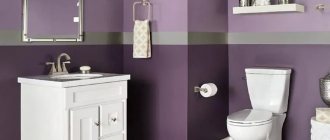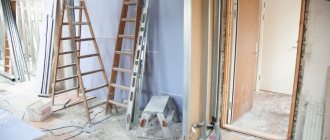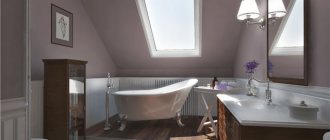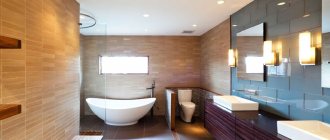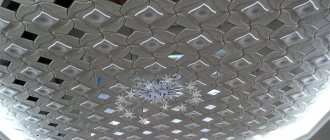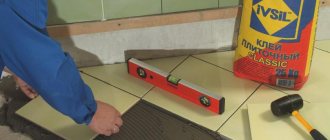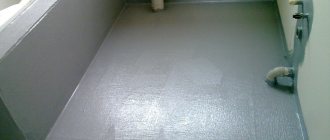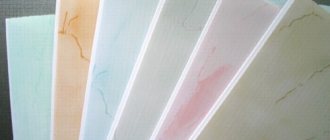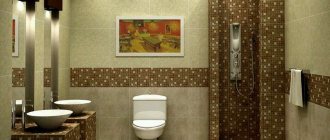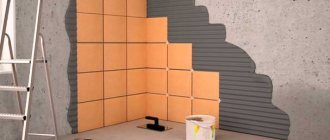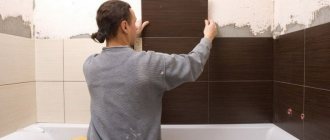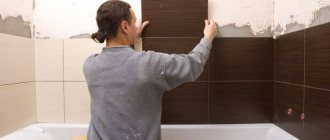Tile is the optimal, but not the only choice for decorating a bathroom. In this article we tell you how to decorate the walls in the bathroom, except for ceramic tiles, and also analyze the options for flooring. We have collected materials that are resistant to moisture, they will not become damp, and mold will not appear in the room. In some cases, even preliminary surface preparation is not required.
Watch the video where we list all the materials
Self-adhesive film
PVC film is a budget option that will help you quickly change the interior of your bathroom. A variety of textures, colors and prints allows you to choose an effective solution for your room design. Raw materials are produced in sheets and rolls, like wallpaper. On the back side of the material there is an adhesive composition covered with protection.
Self-adhesive film is not afraid of high humidity, which allows it to be used in the bathroom. To remove drops and debris, wipe the coating with a rag. The finish is glued only to prepared surfaces. The base can be either a painted wall or boring tiles. Installation is carried out very carefully, otherwise bubbles and distortions will occur.
Fragility is the main disadvantage of film. In wet areas, the self-adhesive will begin to peel off after a few years, and with careless movements it can easily be damaged (torn). Bright colors and images gradually fade. This option is perfect for people who like to change their design frequently with little investment.
Painting walls
Paint is an affordable alternative to bathroom tile. The enamel coating can be either single-color or multi-color. A design with vertical or horizontal stripes helps to visually correct the shortcomings of the room. The author's drawings look luxurious on the partitions in the bathroom. If there is no artistic talent, then stencils are often used.
After drying, the paints create a durable polymer film on the walls. The coating must be resistant to abrasion, household chemicals and steam. In conditions of high humidity, 3 popular types are used:
- Alkyd. Very strong, durable compounds that are easy to apply. The inexpensive material has moderate resistance to impact loads. The pungent odor is the only drawback of the coating.
- Acrylic. Enamels based on polymers and water do not stink and dry quickly. They are inferior in durability to alkyd ones, but are easy to use.
- Latex. Synthetic rubber paints with fungicides are resistant to high humidity and fungus. Operation – 15 years.
The enamel is applied to a previously prepared surface. The walls are cleaned of old finishes, cracks are sealed and depressions are leveled. Before painting, the partitions must be primed and dried thoroughly.
Over time, any enamel fades, cracks, and therefore requires updating. The old layer is washed off with a solvent or removed mechanically. We recommend additionally protecting the surface near the bathtub bowl or in the shower with water-repellent varnish.
Paint in the bathroom Source ourvagabondstories.com
Glass in the bathroom instead of tiles
Glass is a material that has appeared in the design of space in recent years and almost immediately won many supporters. It is ideal for kitchens and bathrooms because it is completely resistant to water and detergents. This offers great decorative possibilities thanks to a huge selection of designs and colors.
Clear, frosted (milk) glass, smooth or porous glass, varnished and coated in a variety of applications are available in the market. Glass blocks are also ideal for bathrooms, with which you can create shower walls, partitions, shelves or fill gaps in the wall, which is a very interesting device.
For the interior of the bathroom, special tempered, laminated or reinforced glass is used, which, in the event of a strong impact, breaks, forming a dense network. Thanks to this, when using glass as a decorative or finishing material, you do not need to worry about the safety of yourself and your family.
Glass can be used to cover an entire wall - large panels of glass in various colors and designs (such as screen-printed) - or smaller pieces combining glass, such as with tiles or paint. An interesting idea is to use mosaics, that is, small glass cubes, to place a bathtub or shower tray.
Decorative plaster
Textured putty is a plastic material with which you can create an original bathroom design. The composition of the raw material includes crushed particles, allowing you to obtain a surface like marble, concrete or brick. After drying, the decorative plaster is painted and protected with a special varnish.
The beauty of the coating depends on the application technology. Three-dimensional drawings of varying complexity, which are created using rollers or spatulas, look luxurious on the walls. In the design of a bathroom, decorative and smooth surfaces are often combined, emphasizing a particular area.
Decorative plaster Source silka.com.ua
To decorate the walls in the bathroom, sanitizing types are used, adapted for use in wet conditions. The material contains synthetic additives that allow you not to be afraid of fungus and maintain a normal microclimate. On average, the durability of high-quality finishing is at least 10 years.
Decorative plaster is applied to prepared and leveled walls. Areas of the wet zone are protected from water with special compounds, otherwise difficult-to-remove limescale stains from the liquid will remain on the surfaces. Glazing solutions and varnishing will help cope with the problem.
Beautiful bathroom design Source poradu24.com
Moisture-resistant wallpaper
Trellis with maximum moisture resistance markings (3 waves) are suitable for use in the bathroom. Popular types include acrylic and vinyl wallpaper. The models are not afraid of a humid microclimate, but will not withstand direct exposure to water. A varnished protection or glass panel will save the wet area from destruction. The alternation of finishing with painting or decorative plaster on the bottom looks original.
Fragility is the main disadvantage of trellises. On average, the material will last no more than 5 years. Even water-resistant types quickly deteriorate in humid conditions. The dense, often multi-layer structure of products provokes the formation of mold and mildew on the walls.
Trellis in the bathroom Source pobudova.in.ua
Flexible stone
The composite type consists of a non-woven base (fiberglass) and a stone filler. The top of the product is coated with a special protective varnish. The finishing is produced in the form of rolls or ready-to-use sheets. Flexible, soft panels can be easily cut into individual pieces with a knife.
Composite material Source arriver71.ru
In the bathroom, the stone composite is glued to the partitions with a fixing compound. The position of the material can be adjusted within 5 minutes, after which the parts are set. The finishing is very light, so the elements do not slip during installation.
Decoration is the main advantage of flexible stone. The raw material visually and to the touch resembles granite, marble or quartz. The material has a high price, which will pay off with durability (more than 20 years) and easy maintenance. The composite does not rot in humid conditions, even with poor ventilation.
Wall panels
Raw materials help to quickly make wall cladding in the bathroom. Under the boards they hide the imperfections of the partitions, making repairs easier and faster. The panels in the room must be installed on a frame, otherwise dampness accumulates under the finishing and mold appears. You can hide plumbing and meters under the structure.
Among the alternatives to tiles in the bathroom, professionals highlight lining. Inexpensive cladding boards are mounted on metal profile sheathing. To prevent the wood from rotting, the surface is protected with an antiseptic and water-repellent varnish. The material should not be installed in a shower stall or next to a bowl. In wet areas it is better to use paint or a glass screen.
Wood for the bathroom instead of tiles
Wood finishes undoubtedly add charm to a bathroom, warm it up and are a natural complement to the dominant ceramics, metal and glass in the interior. Bathroom accessories can be either wooden or larger ones such as a bathtub, shower tray or even flooring. The main thing is to choose the right type of wood for the bathroom, resistant to moisture and temperature changes.
Exotic wood species that work best here include teak, jatobe, cedar, dussi, marbau, iroko, lapacho, badi and wenge - they are characterized by the highest moisture resistance, so they can be placed next to the sink, bathtub or shower. Kempas, guatambu, zebrawood and African walnut (bibola) are slightly less resistant to moisture. You can also choose local tree species such as oak, elm, ash, beech, larch, pine, spruce, cherry and pear.
A very important issue for wood is its adequate protection from moisture, as well as regular impregnation - by varnishing, oiling, staining, waxing or painting - especially for less resistant species.
An interesting arrangement idea is to combine tiles with painted walls. Thanks to this, the bathroom acquires lightness, the decor is not monotonous and not homogeneous. You could, for example, tile up to a certain wall height and cover the top with wallpaper or paint, or tile an entire wall, such as one with a shower or bath, and paint another, such as the one with the washing machine. This solution will also bring savings because you don't have to buy tiles, adhesive and grout to cover the entire bathroom.
As you can see, there are many options for organizing your bathroom space, so you don't have to limit yourself to just tiles. Sometimes it's worth experimenting to find out what other materials can make your interior unique and delightful for years to come.
more
A natural stone
Marble and granite, travertine and onyx bring a touch of luxury to the room. Natural materials are expensive. The cost is compensated by high durability and decorativeness. Wear-resistant stone types can withstand mechanical damage and constant fluctuations in temperature and humidity.
Natural finishes will appear in a large bathroom, but will be invisible in a tiny one. To prevent a room from looking pompous, cladding is often combined with other materials. For example, with decorative plaster, painting or wallpaper. Partial finishing will help place accents or visually change the irregular shape of the bathroom.
Natural stone Source zen.yandex.com
Plasterboard covering
Manufacturers offer special drywall that is green in color and designed for use in rooms with high humidity levels. Features of this finish include:
- installation is considered a simple job that anyone can handle, for which you only need to first attach metal profiles around the perimeter of the walls, which allows you to make a high-quality and even sheathing;
- plasterboard sheets do not have an attractive appearance, so additional decorative finishing is required, for which paint, film or other materials are used;
- The advantages of this method of finishing a bathroom include the absence of the need for preliminary preparation of the base, since the sheets have a significant thickness and density, and therefore hide even significant defects;
- When using plasterboard, the soundproofing parameters of the room are increased.
Attention! This method is not suitable for small rooms, since the sheets significantly narrow the room.
Linoleum
Flooring is an unusual and rare alternative to tiles in the bathroom. When choosing a material, preference is given to thicker models with high moisture resistance. Advanced finishes are more expensive than regular linoleum. Types based on PVC or corundum chips are suitable for use in the bathroom. Products must contain antibacterial impregnations.
The material is cut into pieces or used along the entire length of the wall. The raw materials are glued to the partition using a technology reminiscent of installing wallpaper. The fixing composition for linoleum is distributed on the back side of the product, pressed to the surface, and leveled. Use a spatula or dry cloth to remove any remaining solution. The seams are treated with joint sealant.
Original bathroom design Source build-experts.ru
Agglomerate and self-leveling floor
Agglomerate is often called artificial stone. This material is similar in appearance to ordinary tiles. An important difference is the high wear resistance. The agglomerate is less susceptible to damage and is durable. The elastic structure helps in implementing unusual interior solutions. This type of coating is suitable for decorating round or oval rooms.
The agglomerate can be used to cover floors, walls and other surfaces exposed to moisture.
Self-leveling flooring is considered a suitable option when decorating a bathroom. The material is highly resistant to damage and is reliably protected from scratches and cracks. If dirt, stains or dust appear, the floor surface can be easily cleaned using specialized products. If necessary, a heated floor system can be installed under the main covering.
The surface of the self-leveling floor can be plain or with a pattern
Self-leveling floors with a 3D effect look very impressive
The advantages of self-leveling floors also include solidity. The material is arranged in a full array, which eliminates the possibility of seams or joints.
Self-leveling floor with a spectacular stylization of wet sand
